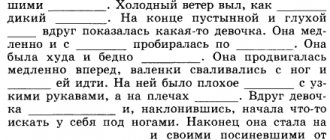Weak positions according to the “softness-hardness” characteristic
There are positions in which hard consonants soften under the influence of neighboring sounds. They are considered weak. This position:
- Before [th']: raven - raven [n'y'o]. The exception is the consonants at the end of the prefix before [th']: [vy'est] - entry.
- Before soft dental sounds for sounds [c], [n], [z]: together [s't']e, [z'd']es.
- Before the phonemes [ch'] and [sch'] for the sound [n]: baraba[n'sch']ik, rulo[n'ch']ik.
In general, it is very difficult to distinguish between strong positions and weak positions on the basis of “hard-soft consonant”. The fact is that it is not possible to select examples for all cases. So, in the Russian language before [n] we only find solid [m]: compote, shampoo, etc. Not a single word has the sound [m'] in this position. Consequently, we cannot be completely sure whether the phoneme [m] or [m'] is realized here.
Positions of consonants: voiceless and voiced
Consonant sounds form pairs according to such characteristics as “voiceless-voiced” and “hard-soft”. Accordingly, strong and weak positions of consonants are also determined by these two characteristics.
A strong position on the basis of “voiceless-voiced” for consonants is the position:
- before a vowel: tom-house, fence-cathedral;
- before sonorants: firewood - grass, layer - evil;
- before the letter “c”: the creator is the palace.
In the listed cases, the consonants are heard clearly and do not require verification. It is hardly possible to make a mistake in writing sonorant sounds that do not have a pair due to deafness. These include [l], [l'], [n], [n'], [p], [p'], [m], [m'], [th']. The phonemes [х], [ц], [х'], [ш'] and [ч'], on the contrary, do not have a voiced paired sound. They can occupy different positions in words, maintaining their basic characteristics and not coinciding with other consonants during pronunciation.
When can consonants be voiced or devoiced?
Now we will learn to distinguish between strong positions and weak positions of paired phonemes based on the voiced-voicedness of phonemes. In what cases are we at risk of making a mistake in writing? This position:
- at the end of a word, where both voiced and voiceless phonemes coincide in their sound: eye - voice, oak - dull, bough - meadow;
- before a paired voiced sound, when the adjacent consonant is also pronounced voiced: shave - [zb]rit, give - o[dd]at;
- before a voiceless consonant, when the adjacent sound is deafened: spoon - lo[shk]a, entrance - [fh]od.
To avoid mistakes, we must understand which morpheme contains the dubious sound. Then find a test word where the required phoneme is in a strong position. So that this does not take much time, you need training. Let's select test words for the examples given above: eye - eyes, voice - voices, oak - oak, tup - stupid, bough - bough, meadow - meadows; shave - fold, give - drive away; spoon - apply, entrance - left.
Absolute positions for consonants
Let's summarize. Everything is clear with vowel sounds. If they are stressed, the position is considered strong. If the stress falls on another phoneme in the word, then the position is weak. It's more complicated with consonants.
For example, in the word “tooth” the sound at the end is deafened. The position on the basis of “voice-voicelessness” will be weak. But it is also strong on the “soft-hard” scale. When the weak positions for both characteristics coincide, the phoneme is considered absolutely weak. It realizes itself in various variations and requires the use of spelling rules.
It happens that a consonant is in a strong position both according to the “voiced-voiceless” characteristic and according to the “soft-hard” characteristic. This is often observed in the position before a vowel sound. This position is called absolutely strong.
Knowing the strong positions and weak positions of phonemes is necessary for every person who wants to write correctly. This will allow you to timely identify the “mistaken” place in the word and remember the corresponding rule.
Consonant positions: hardness and softness
The time has come to consider the strong and weak positions of consonant sounds on such a basis as “hard-soft”. There are many dangers awaiting us here. The morphological principle does not always save. For example, the sounds [zh] and [sh] are always hard, but we know that in some cases a soft sign is written after them (rye, hear). After the hard [ts] there can be the letter “y” (chicken) or “i” (circus).
The sounds [ch'] and [sch'] are always pronounced softly, but from the first grade we remember the spelling of the syllables “cha-sha” and “chu-schu”. There is another principle at work here, called traditional or historical. Only a clear knowledge of the rules of the Russian language will save you from making mistakes.
Nevertheless, let's return to theory. In what case do consonants that have a pair of hardness and softness do not change their qualitative characteristics? This position:
- before a vowel: [mal] - [m'al], [ox] - [v'ol], [bow] - [l'uk], [life'] - [b'it'];
- at the end of the word: [kon] - [kon'], [brother] - [brother'];
- absolutely any for phonemes [l], [l']: vo[l]a - vo[l'n]a, po[l'z]a - po[l]at;
- before back-lingual [g], [k], [x], [g'], [k'], [x'] and hard labial [b], [m], [n] for front-lingual sounds: go [rk] a - go[r'k]o, i[zb]a - re[z'b]a;
- before hard teeth [s], [z], [ts], [d], [t], [l], [n] for teeth: ko[ns]ky - yu[n's]ky;
- before hard front-linguals [s], [z], [t], [d], [ts], [l], [r], [n], [sh], [z] for sonorant front-linguals: jan [rs] cue - September[r's]kiy, ma[nj]eta - de[n'zh]ata.










